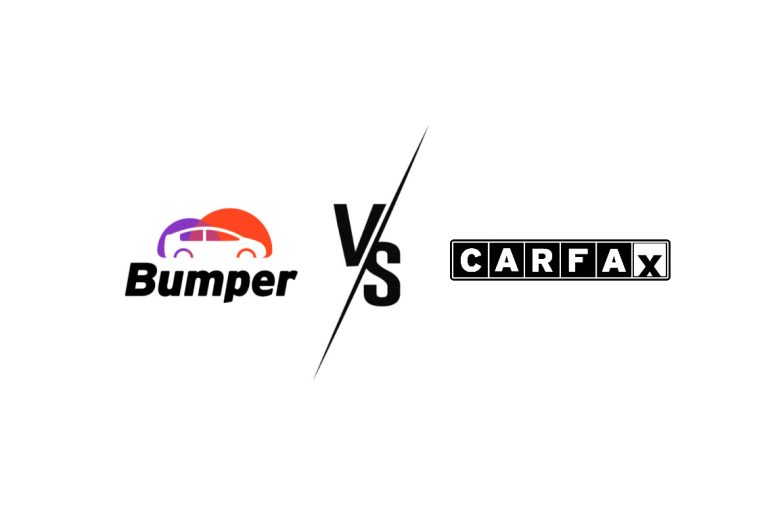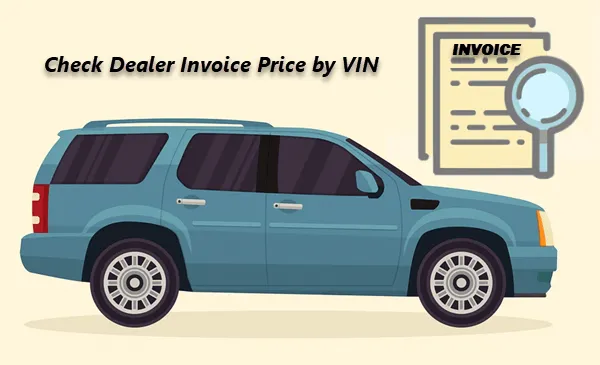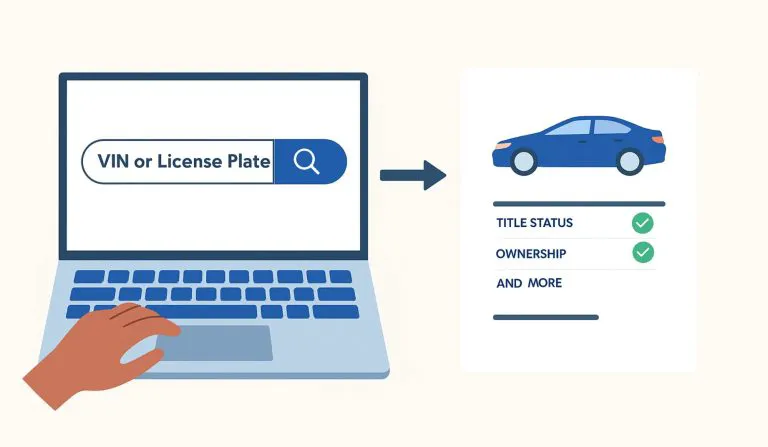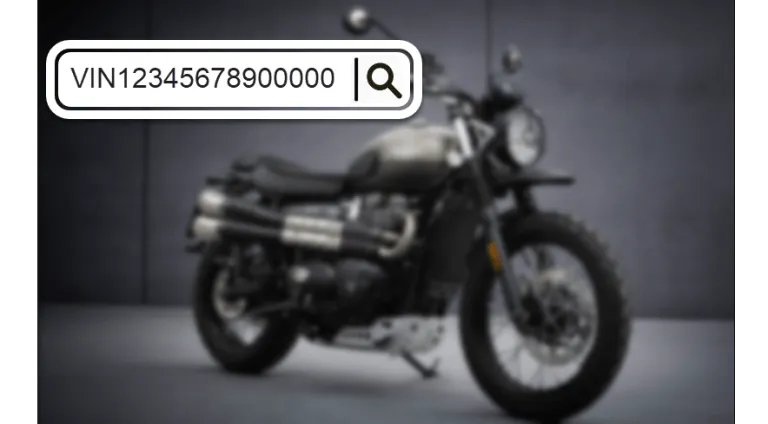ATV VIN Lookup – Check an ATV’s Theft Record, Specs & More

Thinking about buying a 2000 Yamaha Banshee but the seller doesn’t have the title? You’re right to be cautious – there are quite a few stolen ones out there. Or maybe you just picked up a Polaris Xplorer 400 and want to lookup the exact year so you can order the right parts. Whatever the case, as long as you have the ATV (all-terrain vehicle)’s VIN, you can dig up a lot of important details about the vehicle. Read on to learn how…
Quick Guide
- Want both specs and full history? Run a detailed vehicle history report.
- Just need the year, model, or other basic info? Try a free ATV VIN decoder.
- Stolen ATVs are surprisingly common, so stay alert and double-check before buying.
Where to find the VIN on an ATV?
Before you can run any checks, you’ll need to find the ATV’s Vehicle Identification Number (VIN). This 17-character code is unique to each vehicle and acts like its fingerprint. It’s essential for looking up the vehicle’s history, checking if it’s stolen, verifying the model year, and more.
So where is it? Here are the most common places to look:
- Vehicle frame (often on the lower left side, near the front wheel or lower frame rail)
- Steering Column
- Under the seat
- Engine
- Footwell area
The location of the VIN can vary depending on the ATV’s brand and production year. To narrow down your search, you can try searching for official guidance by Googling something like “[brand name] ATV VIN location”. For example, the image below shows a Polaris guide that explains where to find the VIN on models from 2011 to the present, from 1998–2010, and even earlier years.
Also, if you have the owner’s manual or vehicle title, you can check those official documents, the VIN is usually listed there as well.
Use an ATV VIN decoder
If you’re just looking to find out the year of an ATV or check its basic specs, there are plenty of free VIN decoders that can help. One great option is Super Easy VIN Decoder, a free tool powered by the National Highway Traffic Safety Administration (NHTSA) database. Just enter the 17-digit VIN, and within seconds, you’ll learn about the ATV’s make, model, year, manufacturing plant, and even its recall history.
If you’re looking for deeper insights, such as whether the ATV has a theft record or how many previous owners it has had, a full VIN history report is the way to go.
How to check the full history of an ATV by VIN
A detailed vehicle history report from a VIN lookup service can reveal important information about an ATV, such as whether it’s been stolen or how many past owners it’s had. If you want a high-quality report without costing an arm and a leg, Bumper is a solid choice.
While not as well-known as Carfax, Bumper is a fast-growing brand, and importantly, it’s one of the few providers approved by NMVTIS. That means it pulls data straight from the National Motor Vehicle Title Information System, a federal database tracking key data like title history, salvage status, and insurance total losses. In addition to NMVTIS, Bumper also sources data from NHTSA, JD Power, and many other top industry leaders.
How to get a Bumper report
Running a VIN lookup with Bumper is quite easy. Simply visit the Bumper official website, enter the VIN of the ATV, and hit SEARCH.
Then Bumper will check the VIN against the millions of records in its database. (You’ll need to purchase a subscription that fits your needs to access the full report.) Once it locates a match, it will generate a detailed report for you.
When you open the report, you’ll see a navigation bar on the left-hand side. You can click on any section you’re interested in to jump directly to that part of the report. For example, under the Vehicle History category, there’s a section called Theft Records. Clicking it will take you to the detailed theft history, including information like the date, location, and more, if available.
Note that VIN lookup services are only as good as the information they receive. And not all VIN check services access the same sources. While many services pull from overlapping sources, each may also have unique data partnerships. That’s why using more than one service can help you get a fuller picture.
If the Bumper report doesn’t show the information you were looking for, AutoCheck is another good choice. Backed by Experian, AutoCheck is a major player in the VIN lookup industry. Its strong industry presence gives it access to a robust network of automotive data sources. One standout feature is the AutoCheck Score, which rates a vehicle’s history on a scale from 1 to 100. In terms of pricing, a single AutoCheck report costs $29.99, or you can get 5 reports for $59.99. While that’s not as budget-friendly as Bumper, it’s still more affordable than Carfax, which charges $44.99 for just one report.

When the VIN report has no story to tell…
If you’re running a vehicle history report on an ATV, there’s a chance the report might come back with little or no data. That doesn’t necessarily mean the service provider isn’t doing its job. Instead, it’s often because there’s simply no official data tied to the VIN.
Typically, regulations for ATVs are often far less strict than those for regular cars.Some states, like Maine, New Hampshire, or Vermont, don’t require or issue titles for ATVs at all. And in many cases, as long as the ATV is operated only on private land and not on public trails, registration or plating isn’t mandatory either. As a result, many owners have never registered them in the first place.
Because of this, the VIN may not appear in national databases, and the report might not include ownership history, accident reports, or even basic registration records. But still, you have several ways to check the quad’s condition and history:
✅ Do a thorough inspection yourself. Check the frame, plastics, and paint for mismatched parts, fresh welds, or overspray. These could indicate past accidents or rebuilds. Excessive wear on the tires, handlebars, seat, or foot pegs might suggest hard usage.
✅ Request a bill of sale. These might help confirm ownership history, even if there’s no official title.
✅ Take it for a test drive. It lets you feel how the ATV runs, spot any odd noises or handling issues, and get a sense of its overall condition.
✅ Ask the seller directly. An honest seller should be open about how the ATV was used, maintained, and whether it was ever in an accident.
✅ Have a mechanic inspect it. If you’re unsure what to look for, it’s worth bringing in a pro – someone familiar with ATVs. They’ll perform a comprehensive check on the vehicle and might catch things you wouldn’t spot on your own.
How to check if an ATV is stolen
One of your biggest concerns when buying a used ATV is probably ending up with a stolen one, and honestly, that concern makes a lot of sense. ATVs are easy targets for thieves because they’re small, easy to move, and often lack built-in anti-theft features. According to data from the National Insurance Crime Bureau (NICB), 61,196 ATVs were reported stolen between 2016 and 2018, though theft numbers have been gradually declining. Still, when it comes to buying secondhand, it’s always better to be safe than sorry, and it’s essential to make sure you’re not unknowingly purchasing a stolen vehicle.
Image source: nicb.org
In our previous guide How to Check If a Car Is Stolen: A Guide for Used Car Buyers, we covered several effective methods to uncover whether a vehicle has been reported stolen. As a matter of fact, many of those tips apply to ATVs as well.
You can start with online databases where you simply enter the VIN and see if there’s a match in any stolen vehicle records. The NICB’s VINCheck tool is often the go-to resource. You can also try checking Digitpol’s Stolen Car Database, which may include international records. Vehicle history reports, which can pull theft data from a variety of sources, are also a valuable tool, especially if free databases don’t turn up anything. Reliable options include AutoCheck, Bumper, and Carfax.
Beyond online searches, you can also contact local authorities for help. Your local DMV may offer VIN inspections or allow you to bring the ATV in for verification. Police departments can be another resource. For example, if you’re in California, the California Highway Patrol (CHP) handles these cases. One forum user shared that when they were looking into buying a 2002 SUZUKI LT-F250 Ozark with no paperwork, the CHP helped uncover that the ATV was indeed stolen, even though the theft didn’t show up in the NMVTIS database.
Can I buy an ATV without a title?
Since titles often aren’t mandatory for ATVs, as mentioned, above, not all ATVs without a title are suspicious. Some enthusiasts on forums say they’ve bought multiple ATVs and have never even seen a title, but there were no ownership issues. That’s why it’s important to look at the full picture when deciding if an ATV is legit. (Asking for a bill of sale, for example, can help.)
Finding the right ATV can take a bit of digging, but it’s worth it. Take your time, double-check the details, trust your instincts, and happy riding!

 View all of Jocelyn Sun's posts.
View all of Jocelyn Sun's posts.




